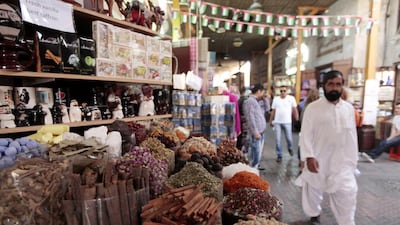Haggling – it’s one of the many perks of living in this region.
While there are many massive super-malls scattered around the country, the UAE also has its fair share of the more traditional souks and markets where costs are often not fixed and price tags are relatively open to negotiation – within reason, of course.
Whether you’re buying an emerald jewellery set at Gold & Diamond Park in Dubai or an electronic drill at Dragon Mart, haggling can often come in handy. I tend to bring my bargaining skills out when shopping for fabric.
Naif Souk is my destination of choice. I hadn’t visited in about a year, but I remember one specific store had a huge variety of feminine, floral prints.
Having been a regular at this store during a six-month period, I would get recognised by the shopkeeper whenever I entered, and I bought about 100 metres of fabric, negotiated a special price – Dh6 per metre, instead of the Dh10 asking price.
______________
Read more:
Easing into a fitness regime with the help of a hammock
Why we shouldn't celebrate this shameful 10-year Kardashian milestone
The branded-watch culture in the UAE can be bewildering
______________
Now, a year later, I push aside the plastic, makeshift door that forms the entrance into the shop, and enter, happy to see the walls to my right and left lined with rolls of new patterns.
I pick out two fabrics – one features olive-hued polka dots and clusters of pastel roses, and the other is a pink cotton printed with lip-shaped lipstick marks. I plan to make some pyjama sets out of these. I request three metres be cut from each print, and remind the shopkeeper of our prior arrangement.
“I’m sorry, no,” he replies, in broken English, and goes on to explain, in a mixture of English and Urdu, that the going rate now is Dh12 per metre, and the best price he can give me is Dh10. When I explain that I’ve bought a lot of material from the store in the past, he doesn’t seem to care.
It’s time to bring out the old bargaining tricks.
I start by expressing my exaggerated exasperation at this ‘revised’ price. Then, I start listing all the fabrics I’ve bought from the shop, for half of that.
He doesn’t seem to give, and starts cutting my fabric anyway. I tell him to stop – I won’t be buying it unless he comes down on the price. And I tell him that if he honours my old rate, I will return to buy more from him next time.
But he still doesn’t agree, so I am forced to pull out the oldest haggling trick in the book and stand up, making my way to the door.
Once I’ve crossed the threshold, back into the busy market, he calls me back – “Take it for Dh10,” he says, almost pleading. “I can’t go lower than that. The prices have increased for these prints since last year, and I need to make some profit, otherwise it will be my loss, and I have a family to feed.”
It seems he has some tricks up his sleeve too, and his attempt to pull at my heartstrings works. I accept his offer and leave.
As I walk back to my car, mentally calculating how much of a difference my old “special rate” would have made, I realise it wouldn’t have made a significant difference to my financial situation, while it certainly may have for his.
While haggling may be an appropriate custom in this region, it’s important to know when to use it, and when to throw in the towel and pay the asking price, especially if it’s already lower than what you would pay at a shopping mall.


